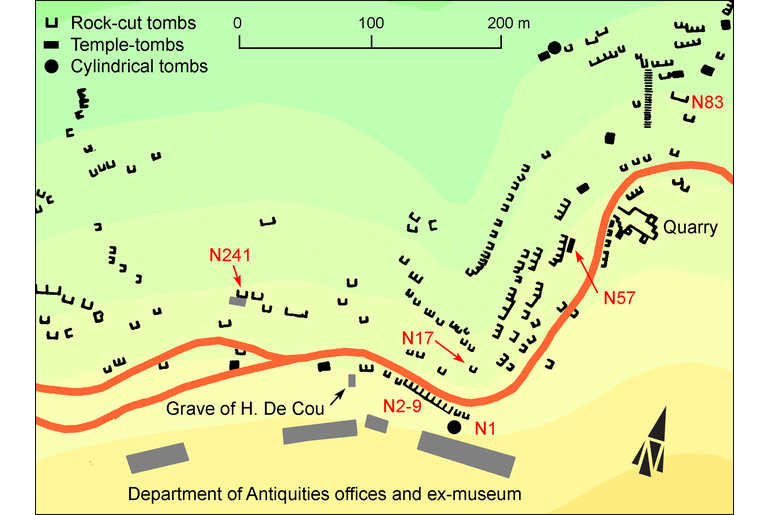Epitaph
IGCyr009900
Trismegistos ID: 105902
Source Description
Support
Lid of rock-cut sarcophagus, limestone (dimensions not recorded).
Layout
a) Roughly cut on slope of lid; b) deeply cut in good letters on the upper plinth of the lid.
Letters
ca. 0.05.
Place of Origin
Findspot.
Date
Fifth to third centuries B.C. (lettering)
Findspot
First copied by H.F. De Cou of the Norton mission in 1911 at Cyrene pleiades; HGL : North Necropolis , tomb N 22.
Last recorded Location
Seen by the Thorns before 2006 in situ.
Present Location
Not seen by IGCyr team.
Text constituted from
Transcription from editor.
Bibliography
Robinson, 1913 Robinson, D.M., 1913, Inscriptions from the Cyrenaica, American Journal of Archaeology (AJA)17, 157-200 - see in bibliography , n. 26, without illustration, whence Sammelbuch Preisigke, F. et al. (eds.), Sammelbuch griechischer Urkunden aus Ägypten, Strassburg/Wiesbaden1915- - see in bibliography 5880; Cassels, 1955 Cassels, J., 1955, The cemeteries of Cyrene, Papers of the British School at Rome (PBSR)23, 1-43 - see in bibliography , p. 10, n. 11; Marengo, 1991 Marengo, S.M., 1991, Lessico delle iscrizioni greche della Cirenaica, Studi pubblicati dall’Istituto italiano per la Storia antica49, Roma - see in bibliography , p. 33; Thorn-Thorn, 2009 Thorn, D.M., Thorn, J.C. (eds.), 2009, A Gazetteer of the Cyrene Necropolis from the original notebooks of John Cassels, Richard Tomlinson and James and Dorothy Thorn, Studia Archaeologica161, Roma - see in bibliography , p. 31.
Apparatus
A.1 Ἀγ̣α̣θ̣ίνα : Robinson, 1913
Robinson, D.M., 1913, Inscriptions from the Cyrenaica, American Journal of Archaeology (AJA)17, 157-200 - see in bibliography
Ἄπλοινα
B.1 hιπ<π>οσ[---] : Robinson, 1913
Robinson, D.M., 1913, Inscriptions from the Cyrenaica, American Journal of Archaeology (AJA)17, 157-200 - see in bibliography
HΙΠΟΣ : Sammelbuch
Preisigke, F. et al. (eds.), Sammelbuch griechischer Urkunden aus Ägypten, Strassburg/Wiesbaden1915- - see in bibliography
hιπποσ[---]
(reading Keil)
French translation
A: Agathina.
B: Hippos[---] .
English translation
A: Agathina.
B: Hippos[---] .
Italian translation
A: Agathina.
B: Hippos[---] .
Commentary
Dorothy Thorn's photograph shows A still readable, because it remained covered by earth, whereas B, exposed to the air since at least 1911, can hardly be traced on the photograph. However, it is clear that only one pi was cut, which as such gives no sense in Greek. The use of the letter H for the initial aspiration and of only one letter for a double stop are two clues for an archaic lettering. Section B would thus be earlier than A.
A : The unknown name Ἄπλοινα was already rejected as doubtful both in Fraser-Matthews, 1987 Fraser, P.M., Matthews, E. (eds.), 1987, Lexicon of Greek Personal Names, I: The Aegean Islands, Cyprus, Cyrenaica, Oxford - see in bibliography and by Marengo. The Thorns were not aware of those doubts.
B : Keil thought of Ἱππόσ[τρατος], but Ἱπποσ[θένης] would be another possibility. Anyhow, there was probably no room for so long names on the plinth. Either it was cut on on the other sides of the plinth or the name was abbreviated.
Arabic translation
أ: أجاثينا. ب: هيبوس [---].
Creative Commons Attributions-NonCommercial 4.0 International License.
All citation, reuse or distribution of this work must contain a link back to DOI: http://doi.org/10.6092/UNIBO/IGCYRGVCYR and the filename (IGCyr000000 or GVCyr000), as well as the year of consultation.
